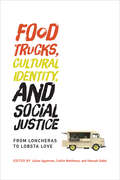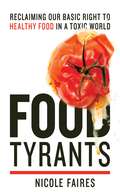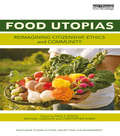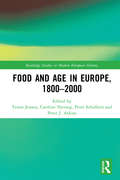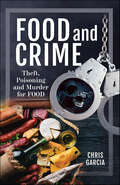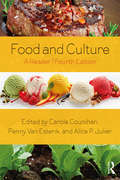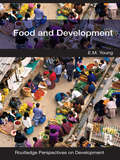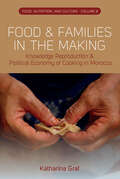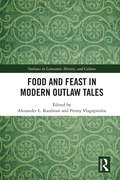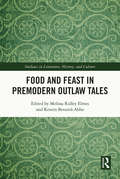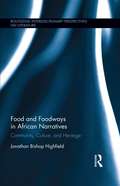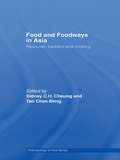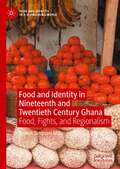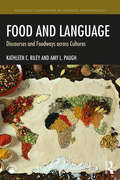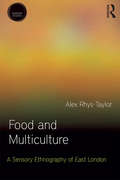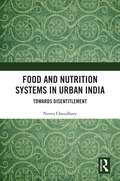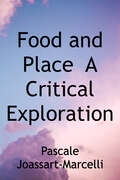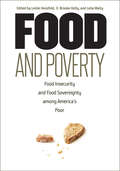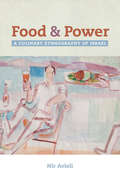- Table View
- List View
Food Trucks, Cultural Identity, and Social Justice: From Loncheras to Lobsta Love (Food, Health, and the Environment)
by Julian Agyeman Caitlin Matthews Hannah SobelAspects of the urban food truck phenomenon, including community economic development, regulatory issues, and clashes between ethnic authenticity and local sustainability.The food truck on the corner could be a brightly painted old-style lonchera offering tacos or an upscale mobile vendor serving lobster rolls. Customers range from gastro-tourists to construction workers, all eager for food that is delicious, authentic, and relatively inexpensive. Although some cities that host food trucks encourage their proliferation, others throw up regulatory roadblocks. This book examines the food truck phenomenon in North American cities from Los Angeles to Montreal, taking a novel perspective: social justice. It considers the motivating factors behind a city's promotion or restriction of mobile food vending, and how these motivations might connect to or impede broad goals of social justice. The contributors investigate the discriminatory implementation of rules, with gentrified hipsters often receiving preferential treatment over traditional immigrants; food trucks as part of community economic development; and food trucks' role in cultural identity formation. They describe, among other things, mobile food vending in Portland, Oregon, where relaxed permitting encourages street food; the criminalization of food trucks by Los Angeles and New York City health codes; food as cultural currency in Montreal; social and spatial bifurcation of food trucks in Chicago and Durham, North Carolina; and food trucks as a part of Vancouver, Canada's, self-branding as the “Greenest City.”ContributorsJulian Agyeman, Sean Basinski, Jennifer Clark, Ana Croegaert, Kathleen Dunn, Renia Ehrenfeucht, Emma French, Matthew Gebhardt, Phoebe Godfrey, Amy Hanser, Robert Lemon, Nina Martin, Caitlin Matthews, Nathan McClintock, Alfonso Morales, Alan Nash, Katherine Alexandra Newman, Lenore Lauri Newman, Alex Novie, Matthew Shapiro, Hannah Sobel, Mark Vallianatos, Ginette Wessel, Edward Whittall, Mackenzie Wood
Food Tyrants: Fight for Your Right to Healthy Food in a Toxic World
by Nicole FairesWhen author and homesteader Nicole Faires decided to retrofit an old school bus and tour America's small farms with her husband and two small children, she expected to learn a lot, be inspired, and have some fun. But what she fou
Food Utopias: Reimagining citizenship, ethics and community (Routledge Studies in Food, Society and the Environment)
by Michael Carolan Christopher Rosin Paul V. StockFood is a contentious and emotive issue, subject to critiques from multiple perspectives. Alternative food movements – including the different articulations of local, food miles, seasonality, food justice, food knowledge and food sovereignty – consistently invoke themes around autonomy, sufficiency, cooperation, mutual aid, freedom, and responsibility. In this stimulating and provocative book the authors link these issues to utopias and intentional communities. Using a food utopias framework presented in the introduction, they examine food stories in three interrelated and complementary ways: utopias as critique of existing systems; utopias as engagement with experimentation of the novel, the forgotten, and the hopeful in the future of the food system; and utopias as process that recognizes the time and difficulty inherent in changing the status quo. The chapters address theoretical aspects of food utopias and also present case studies from a range of contexts and regions, including Argentina, Italy, Switzerland and USA. These focus on key issues in contemporary food studies including equity, locality, the sacred, citizenship, community and food sovereignty. Food utopias offers ways forward to imagine a creative and convivial food system.
Food Waste at Consumer Level: A Comprehensive Literature Review (SpringerBriefs in Environmental Science)
by Ludovica PrincipatoThis book presents what is the state-of-the-art in the field of the food waste phenomenon at consumer level, including a thorough literature review, and it highlights trends in the field. It provides a comprehensive starting point for future research. Food waste represents a major public policy issue, which is included in the UN Sustainable Development Goals. In this context, the present work identifies the most important definitions given to food waste and its environmental, social and economic impacts. With a comprehensive literature review that covers a forty-year time span (1977-2017), this book highlights the multiple, complex facets of food waste at the consumer level. Drawing from behavioural and marketing theories, it proposes a new theoretical framework with the aim to better explain food waste behaviour. Extensive research is being carried out on the main worldwide initiatives (both public and private) and food policies aimed at tackling the phenomenon.
Food and Age in Europe, 1800-2000 (Routledge Studies in Modern European History)
by Tenna Jensen Caroline Nyvang Peter Scholliers Peter J. AtkinsPeople eat and drink very differently throughout their life. Each stage has diets with specific ingredients, preparations, palates, meanings and settings. Moreover, physicians, authorities and general observers have particular views on what and how to eat according to age. All this has changed frequently during the previous two centuries. Infant feeding has for a long time attracted historical attention, but interest in the diets of youngsters, adults of various ages, and elderly people seems to have dissolved into more general food historiography. This volume puts age on the agenda of food history by focusing on the very diverse diets throughout the lifecycle.
Food and Crime: Theft, Poisoning and Murder for Food
by Chris GarciaAnyone alive, and wanting to stay that way, must deal with food. Crime is, and always has been, present. Food and Crime examines the crossroads of these two universal forces, how hunger can lead to theft, fraud, and murder, and how the well-fed will sometimes do anything to keep their bellies full. From the one-timers to the career caper-planners, food criminals are a wide-ranging, often audacious bunch, and this is the record of their impact, great and small. From a war fought by the Mayor of New York over tasty thistles, to the role McDonald's plays in the American culinary conscious, to how foreign food aid abuse led to a mighty fall in the financial sector, these sixteen stories of criminals who engage with the world of cuisine, cookery, or agriculture cover food and crime from the piddliest pilfering to the most diabolical murders. Covering the period from the Ancient Greeks (who invented insurance fraud) to the effects of COVID-19 on seafood crime in the true crime capital of America - Florida, here's clear evidence that there's never been a time when food and crime were not intimately entangled. Food and Crime sheds light on the unexpected, and sometimes unbelievable, connections between two things that we can never seem to get enough of.
Food and Culture, 8e
by Nina Mukerjee Furstenau SeAnne Safaii-Waite Kathryn P. Sucher Marcia Nahikian-Nelms Pamela Goyan KittlerProviding current information on the health, culture, food, and nutrition habits of the most common ethnic and racial groups living in the United States, Food and Culture supports human diversity and inclusivity and provides you with an accessible lens to see the connection. This market-leading text for cultural foods courses is also designed to help health professionals, chefs, and others in the food service industry learn to work effectively with members of different ethnic and religious groups in a culturally sensitive manner. It also will help you develop a grounded perspective of the diversity in the United States and enhance effective communication across cultures in any field of work. The authors include comprehensive coverage of key ethnic, religious and regional groups, including Native Americans, Europeans, Africans, Black Americans, Mexicans and Central Americans, Caribbean Islanders, South Americans, Chinese, Japanese, Koreans, Southeast Asians, Pacific Islanders, people of the Balkans, Middle Easterners, Asian Indians, and regional Americans.
Food and Culture: A Reader (Food In History And Culture Ser. #Vol. 1.)
by Carole Counihan Penny Van Esterik Alice JulierThis innovative and global best-seller helped establish food studies courses throughout the social sciences and humanities when it was first published in 1997. The fourth edition of Food and Culture contains favorite articles from earlier editions and several new pieces on food politics, globalism, agriculture, and race and gender identity.
Food and Development (Routledge Perspectives on Development)
by E. M. YoungThe relationship between food and development has always been controversial. Over the last thirty years, development in the north and south has failed to deliver people a decent diet. While some people have too little food and die as a consequence, some people have too much food and die from associated diseases. Furthermore, some methods of food production create social dislocation and deadly environments where biodiversity is eroded and pollution is rampant. While guaranteeing enough food for the world’s inhabitants continues to be a serious challenge, new issues about food have emerged. Food and Development is a lively and lucidly written text which provides a clear and accessible introduction to these complex and diverse food related problems. It explores the continued prevalence of mass under nutrition in the developing world; acute food crises in some places associated with conflict; the emergence of over nutrition in the developing world and the vulnerability of the contemporary global food production system. The text identifies the major problems and analyzes factors at international, national and local scales to understand their continued prevalence. The book concludes by evaluating the potential of some oppositional forces to challenge the hegemony of the contemporary food system. This timely and original text will be invaluable to undergraduates interested in the challenges surrounding food and development. The text is richly filled with case studies from the Global North and South to illustrate the nature and extent of these urgent issues and their interrelated nature. Each chapter contains a range of features to assist undergraduate learning, including: learning objective, key concepts, summaries, discussion questions, further reading and websites, and follow up activities.
Food and Families in the Making: Knowledge Reproduction and Political Economy of Cooking in Morocco (Food, Nutrition, and Culture #8)
by Katharina GrafEven in the context of rapid material and social change in urban Morocco, women, and especially those from low-income households, continue to invest a lot of work in preparing good food for their families. Through the lens of domestic food preparation, this book looks at knowledge reproduction, how we know cooking and its role in the making of everyday family life. It also examines a political economy of cooking that situates Marrakchi women’s lived experiences in the broader context of persisting poverty and food insecurity in Morocco.
Food and Feast in Modern Outlaw Tales (Outlaws in Literature, History, and Culture)
by Penny Vlagopoulos Alexander L. KaufmanThis collection of scholarly essays presents new work from in an emerging line of inquiry: modern outlaw narratives and the textual and cultural relevance of food and feasting. Food, its preparation and its consumption, is presented in outlaw narratives as central points of human interaction, community, conflict, and fellowship. Feast scenes perform a wide variety of functions, serving as cultural repositories of manners and behaviors, catalysts for adventure, or moments of regrouping and redirecting narratives. The book argues that modern outlaw narratives illuminate a potent cross-cultural need for freedom, solidarity, and justice, and it examines ways in which food and feasting are often used to legitimate difference, create discord, and manipulate power dynamics.
Food and Feast in Premodern Outlaw Tales (Outlaws in Literature, History, and Culture #8)
by Melissa Ridley Elmes Kristin Bovaird-AbboIn Food and Feast in Premodern Outlaw Tales editors Melissa Ridley Elmes and Kristin Bovaird-Abbo gather eleven original studies examining scenes of food and feasting in premodern outlaw texts ranging from the tenth through the seventeenth centuries and forward to their cinematic adaptations. Along with fresh insights into the popular Robin Hood legend, these essays investigate the intersections of outlawry, food studies, and feasting in Old English, Middle English, and French outlaw narratives, Anglo-Scottish border ballads, early modern ballads and dramatic works, and cinematic medievalism. The range of critical and disciplinary approaches employed, including history, literary studies, cultural studies, food studies, gender studies, and film studies, highlights the inherently interdisciplinary nature of outlaw narratives. The overall volume offers an example of the ways in which examining a subject through interdisciplinary, cross-geographic and cross-temporal lenses can yield fresh insights; places canonic and well-known works in conversation with lesser-known texts to showcase the dynamic nature and cultural influence and impact of premodern outlaw tales; and presents an introductory foray into the intersection of literary and food studies in premodern contexts which will be of value and interest to specialists and a general audience, alike.
Food and Festivals: India
by Mike HirstINDIA Let your mouth water and your tastebuds tingle as you find out all about Indian food and festivals in this book. Did you know that throwing rice at newlyweds comes from a tradition at weddings in India? Choose which gifts of candies you would like to receive at the festival of Diwali. Try the festival recipes inside to taste the flavor of INDIA.
Food and Foodways in African Narratives: Community, Culture, and Heritage (Routledge Interdisciplinary Perspectives on Literature)
by Jonathan Bishop HighfieldFood is a defining feature in every culture. Despite its very basic purpose of sustaining life, it directly impacts the community, culture and heritage in every region around the globe in countless seen and unseen ways, including the literature and narratives of each region. Across the African continent, food and foodways, which refer to the ways that humans consume, produce and experience food, were influened by slavery and forced labor, colonization, foreign aid, and the anxieties prompted by these encounters, all of which can be traced through the ways food is seen in narratives by African and colonial storytellers. The African continent is home to thousands of cultures, but nearly every one has experienced alteration of its foodways because of slavery, transcontinental trade, and colonization. Food and Foodways in African Narratives: Community, Culture, and Heritage takes a careful look at these alterations as seen through African narratives throughout various cultures and spanning centuries.
Food and Foodways in Asia: Resource, Tradition and Cooking (Anthropology of Asia)
by Tan Chee-Beng Sidney C.H. CheungFood is an important cultural marker of identity in contemporary Asian societies, and can provide a medium for the understanding of social relations, family and kinship, class and consumption, gender ideology, and cultural symbolism. However, a truly comprehensive view of food cannot neglect the politics of food production, in particular, how, when, from where and even why different kinds of food are produced, prepared and supplied. Food and Foodways in Asia is an anthropological inquiry providing rich ethnographic description and analysis of food production as it interacts with social and political complexities in Asia’s diverse cultures. Prominent anthropologists examine how food is related to ethnic identity and boundary formation, consumerism and global food distribution, and the invention of local cuisine in the context of increasing cultural contact. With chapters ranging from the invention of 'local food' for tourism development, to Asia's contribution to ‘world cuisine,’ Food and Foodways in Asia will be a fascinating read for anyone interested in the anthropology of food and/or Asian studies.
Food and Gender: Identity and Power (Food In History And Culture Ser. #Vol. 1.)
by Carole M. Counihan Steven L. KaplanThis volume examines, among other things, the significance of food-centered activities to gender relations and the construction of gendered identities across cultures. It considers how each gender's relationship to food may facilitate mutual respect or produce gender hierarchy. This relationship is considered through two central questions: How does control of food production, distribution, and consumption contribute to men's and women's power and social position? and How does food symbolically connote maleness and femaleness and establish the social value of men and women? Other issues discussed include men's and women's attitudes towards their bodies and the legitimacy of their appetites.
Food and Identity in Nineteenth and Twentieth Century Ghana: Food, Fights, and Regionalism (Food and Identity in a Globalising World)
by Brandi Simpson MillerThis book investigates how cooking, eating, and identity are connected to the local micro-climates in each of Ghana’s major eco-culinary zones. The work is based on several years of researching Ghanaian culinary history and cuisine, including field work, archival research, and interdisciplinary investigation. The political economy of Ghana is used as an analytical framework with which to investigate the following questions: How are traditional food production structures in Ghana coping with global capitalist production, distribution, and consumption? How do land, climate, and weather structure or provide the foundation for food consumption and how does that affect the separate traditional and capitalist production sectors? Despite the post WWII food fight that launched Ghana’s bid for independence from the British empire, Ghana’s story demonstrates the centrality of local foods and cooking to its national character. The cultural weight of regional traditional foods, their power to satisfy, and the overall collective social emphasis on the ‘proper’ meal, have persisted in Ghana, irrespective of centuries of trade with Europeans. This book will be of interest to scholars in food studies, comparative studies, and African studies, and is sure to capture the interest of students in new ways.
Food and Language: Discourses and Foodways across Cultures
by Amy L. Paugh Kathleen C. RileyFood and Language: Discourses and Foodways across Cultures explores in innovative ways how food and language are intertwined across cultures and social settings. How do we talk about food? How do we interact in its presence? How do we use food to communicate? And how does social interaction feed us? The book assumes no previous linguistic or anthropological knowledge but provides readers with the understanding to pursue further research on the subject. With a full glossary at the end of the book and additional tools hosted on an eResources page (such as recommended web and video links and some suggested research exercises), this book serves as an ideal introduction for courses on food, language, and food-and-language in anthropology departments, linguistics departments, and across the humanities and social sciences. It will also appeal to any reader interested in the semiotic interplay between food and language.
Food and Medicine: A Biosemiotic Perspective (Biosemiotics #22)
by Jonathan Hope Yogi Hale HendlinThis edited volume provides a biosemiotic analysis of the ecological relationship between food and medicine. Drawing on the origins of semiotics in medicine, this collection proposes innovative ways of considering aliments and treatments. Considering the ever-evolving character of our understanding of meaning-making in biology, and considering the keen popular interest in issues relating to food and medicines - fueled by an increasing body of interdisciplinary knowledge - the contributions here provide diverse insights and arguments into the larger ecology of organisms’ engagement with and transformation through taking in matter. Bodies interpret molecules, enzymes, and alkaloids they intentionally and unintentionally come in contact with according to their pre-existing receptors. But their receptors are also changed by the experience. Once the body has identified a particular substance, it responds by initiating semiotic sequences and negotiations that fulfill vital functions for the organism at macro-, meso-, and micro-scales. Human abilities to distill and extract the living world into highly refined foods and medicines, however, have created substances far more potent than their counterparts in our historical evolution. Many of these substances also lack certain accompanying proteins, enzymes, and alkaloids that otherwise aid digestion or protect against side-effects in active extracted chemicals. Human biology has yet to catch up with human inventions such as supernormal foods and medicines that may flood receptors, overwhelming the body’s normal satiation mechanisms. This volume discusses how biosemioticians can come to terms with these networks of meaning, providing a valuable and provocative compendium for semioticians, medical researchers and practitioners, sociologists, cultural theorists, bioethicists and scholars investigating the interdisciplinary questions stemming from food and medicine.
Food and Multiculture: A Sensory Ethnography of East London (Sensory Studies)
by Alex Rhys-TaylorIn this book, Alex Rhys-Taylor offers a ground-breaking sensory ethnography of East London. Drawing on the multicultural context of London, one of the most cosmopolitan cities in the world, he explores concepts such as gentrification, class antagonism, new ethnicities and globalization. Rhys-Taylor shows how London is characterized by its rich history of socioeconomic change and multiculture, exploring how its smells and food are integral to understanding both its history and the reality of London’s urban present. From the fiery chillies sold by street grocers which are linked to years of cultural exchange, through ‘cuisines of origin’ like jellied eels to hybridized dishes such as the chicken katsu wrap, sensory experiences are key to understanding the complex cultural genealogies of the city and its social life.Each of the eight chapters combines micro histories of ingredients such as fried chicken, bush-meat and curry sauce, featuring narratives from individuals that provide a unique, engaging account of the evolution of taste and culture through time and space.With its innovative methodology, this is a highly original contribution to the fields of sensory studies, food studies, urban studies and cultural studies.
Food and Nutrition Systems in Urban India: Towards Disentitlement
by Neetu ChoudharyThis book explores identity-mediated dynamics of food and nutrition entitlement in urban India analysing concerns around equity, access to food and public health. The issues of disentitlement and identity dynamics when it comes to nutrition and health are more intricate in the urban context, due to a greater population and cultural diversity. While in the global north, urban food planning is increasingly dependent on local government, in developing countries urban nutrition is yet to be considered a serious policy issue. This book, with a disaggregated analysis for urban India and an in-depth case study of Mumbai, examines how malnutrition in India is becoming an urban challenge. It discusses how far caste, religion and migratory identities serve as a source of deprivation and analyses the role of local governance, particularly municipal governance and urban planning, in facilitating the disentitlement. It also offers suggestions for the global south to reverse the stark inequality in its urban centres and address nutrition challenges by developing their own sustainable and resilient food systems. This book is an essential read for scholars and researchers of public health, nutrition, urban sociology, urban planning, development studies, political sociology, public policy and political studies.
Food and Place: A Critical Exploration
by Pascale Joassart-MarcelliThis text provides a comprehensive and critical exploration of food from the unique perspective of place. It shows that our experiences with food are deeply influenced by their cultural, social, economic, and political contexts. <p><p>The authors explore a wide range of questions such as: Do GMOs threaten rural livelihoods? Why don't we eat dogs? Does your neighborhood make you fat? Do community gardens encourage urban gentrification? Can cheese save a local economy? Why are gourmet burgers appearing on menus all over the world? How do immigrants use food to create a sense of place? Does mainstream nutrition stigmatize bodies? Is the kitchen an oppressive place? Can celebrity chefs change the food system? <p><p>Critically engaged and connected to current activist and academic debates, Food and Place will be an essential resource for students across the social sciences.
Food and Poverty: Food Insecurity and Food Sovereignty among America's Poor
by Leslie Hossfeld E. Brooke Kelly Julia WaityFood insecurity rates, which skyrocketed with the Great Recession, have yet to fall to pre-recession levels. Food pantries are stretched thin, and states are imposing new restrictions on programs like SNAP that are preventing people from getting crucial government assistance. At the same time, we see an increase in obesity that results from lack of access to healthy foods. The poor face a daily choice between paying bills and paying for food.
Food and Poverty: Food Insecurity and Food Sovereignty among America's Poor
by Leslie H. Hossfeld, E. Brooke Kelly, and Julia F. WaityFood insecurity rates, which skyrocketed with the Great Recession, have yet to fall to pre-recession levels. Food pantries are stretched thin, and states are imposing new restrictions on programs like SNAP that are preventing people from getting crucial government assistance. At the same time, we see an increase in obesity that results from lack of access to healthy foods. The poor face a daily choice between paying bills and paying for food.
Food and Power: A Culinary Ethnography of Israel
by Nir AvieliDrawing on ethnography conducted in Israel since the late 1990s, Food and Power considers how power is produced, reproduced, negotiated, and subverted in the contemporary Israeli culinary sphere. Nir Avieli explores issues such as the definition of Israeli cuisine, the ownership of hummus, the privatization of communal Kibbutz dining rooms, and food at a military prison for Palestinian detainees to show how cooking and eating create ambivalence concerning questions of strength and weakness and how power and victimization are mixed into a sense of self-justification that maintains internal cohesion among Israeli Jews.
